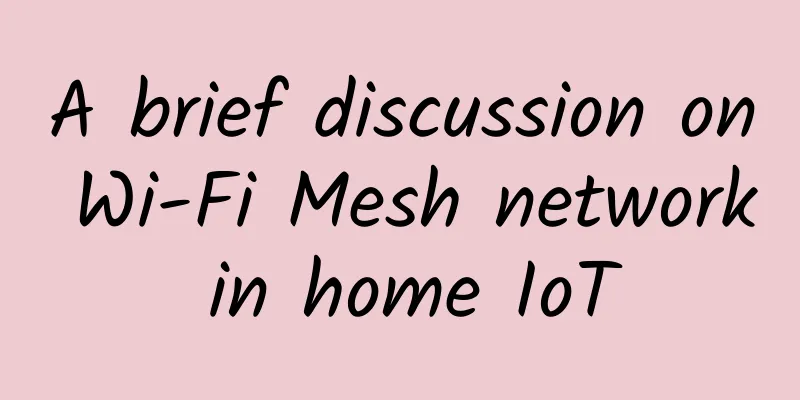A brief discussion on Wi-Fi Mesh network in home IoT

|
Author: Fan Deyang, unit: China Mobile Smart Home Operation Center Labs GuideIn recent years, more and more smart home devices have been pouring into ordinary people's homes. With the increase of smart home devices, such as audio, TV, washing machine, surveillance camera, lighting, automatic curtains, etc., connected to a home IoT network, it is often easy to cause network loading difficulties or even network abnormalities of the devices, and the remote control cannot be completed. So what is going on? After reading this article, you may have the answer. Part 01 Opportunities of Wi-Fi MeshThe addition of more and more smart home devices to the home IoT network often leads to device network anomalies, resulting in problems such as being unable to remotely control or view device status. The reason is that most traditional home IoT networks use a star structure, with only one ordinary router connected to N independent smart device nodes at the end, while the number of devices that can be connected to the IoT gateway is limited. As shown in Figure 1, when there are many device nodes and they run at the same frequency, signal conflicts may occur; in addition, when a device node cannot access the gateway due to an obstacle, the device will lose connection, unable to upload data, and unable to be controlled. Figure 1 Part 02 What is Wi-Fi Mesh NetworkThe so-called Wi-Fi Mesh network is a wireless mesh network, also known as a multi-hop network, as the name implies. As shown in Figure 2, in a Wi-Fi Mesh network, nodes are connected to each other wirelessly, each device node can also serve as a router, each node can receive or relay data to the next connected node, and each device node can communicate with one or more corresponding nodes. Therefore, the entire network does not rely on a single device node. Even if a node cannot be directly accessed due to a fault, it can still be accessed through other connected links in the network, which greatly improves the robustness of the network. Figure 2 Part 03 Features of Wi-Fi Mesh Network
Part 04 ConclusionAlthough Wi-Fi Mesh network technology still has some shortcomings, for example, the Wi-Fi Mesh network solutions of manufacturers on the market are all defined and designed by themselves, and there is no unified standard, which makes the routers between different manufacturers incompatible when building a Mesh network. However, given its advantages and with the continuous changes in Wi-Fi Mesh technology and the continuous standardization of industry standards, we look forward to more and more mature solutions for Wi-Fi Mesh in home IoT applications. |
<<: Google Fiber: 5 Gbps and 8 Gbps services coming early next year
>>: What exactly is the cache technology that supports high concurrency?
Recommend
Tencent Cloud offers a 40% discount on domain name renewals, com renewals for 39 yuan, cn renewals for 21 yuan
Friends who have domain names in Tencent Cloud ca...
How Industry 4.0 and 5G will change supply chain visibility
As the pandemic highlights the serious inefficien...
CYUN: 20% off on all VPS, 50% off for old users, Hong Kong VPS monthly payment starts from 14.5 yuan
CYUN is a cloud computing service brand under Hon...
New infrastructure is just starting, 5G is just beginning, and the key year for smartphones is 2021
"New infrastructure" is one of the core...
With the rapid development of 5G, operators have drastically cut marketing expenses. How can agents survive?
Relying on a large number of agents, China Mobile...
UFOVPS National Day promotion starts at 30% off, top up 200 yuan and get 20 yuan, Hong Kong CN2/Japan CN2 optional
UFOVPS is currently carrying out a National Day p...
HostYun: Hong Kong high bandwidth VPS monthly payment starts from 18 yuan, single core/1G memory/10G SSD/50M port
Let me share some information about HostYun's...
China Radio and Television faces three major challenges on its 5G journey
Since the Ministry of Industry and Information Te...
No need for WiFi, can you surf the Internet with light? China releases the first visible light communication chip
No need for WiFi, can you surf the Internet with ...
Interpretation of China's first LTE IoT multi-mode field test: Industry chain collaboration resolves the long-tail fragmentation problem
Recently, Qualcomm has cooperated with China Mobi...
Where will the evolution of SD-WAN go?
Since the advent of SD-WAN technology five years ...
A world first! Traffic lights are used as 5G base stations: Japan has come up with a wave of cool operations
The small signal coverage range of 5G base statio...
To get rid of the embarrassment, my country needs a "devil's pace" to accelerate IPv6
Artificial intelligence, big data, cloud computin...
my country will compete for the leading position in 5G communication coding standards
The Polar code launched by Chinese technology com...
HostKvm newly launched China Unicom CUVIP line VPS, 1G memory package starts at $5.2/month after 20% discount
Recently, more and more merchants have connected ...







![[11.11] HostXen's bandwidth upgrade, recharge 100 yuan and get 20 yuan free, and add a new data center in Tokyo, Japan](/upload/images/67cabd2da9a2e.webp)

